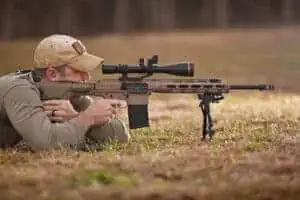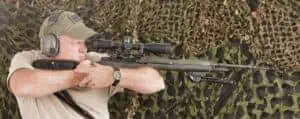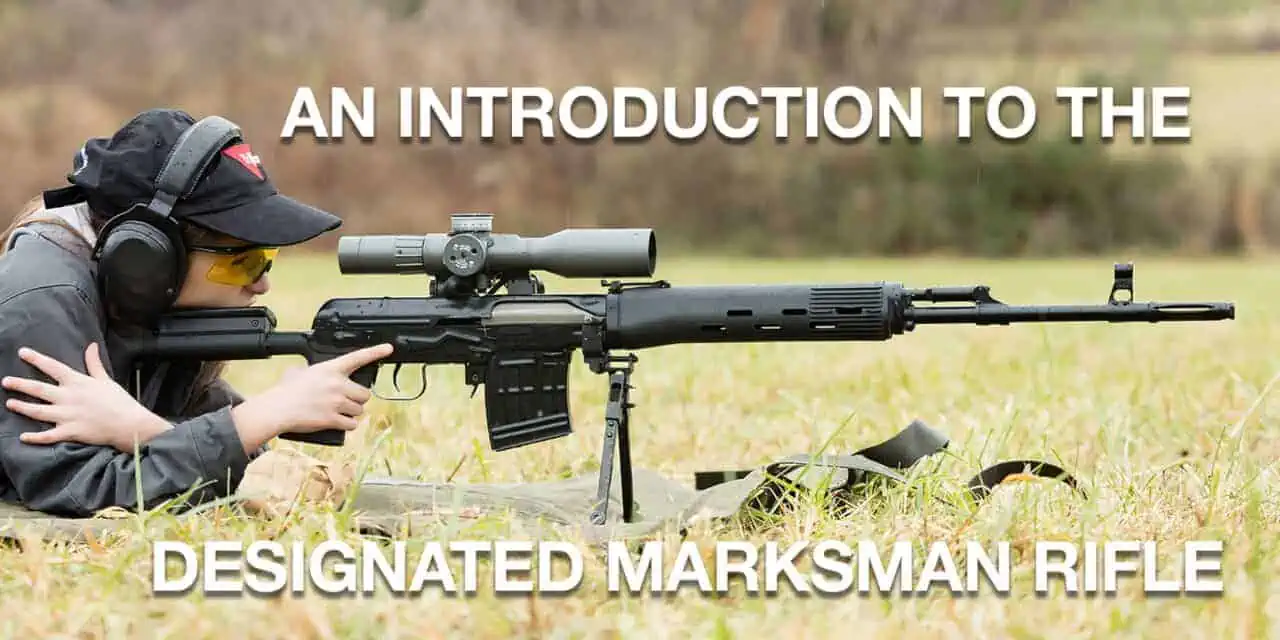The Theory And Use Of The Designated Marksman Rifle
The citizen rifleman is one of the foundations of American gun culture. The images of the Minutemen at Concord Bridge and the defenders of the Alamo are just two examples of how rifle marksmanship has become part of American lore. The National Rifle Association was founded to provide rifle training for America’s citizens. In addition to this, the Second Amendment revolves around the idea that the common people should have the right to keep and bear arms.
The military also has a need for accurate rifle shooting at longer distances. Britain’s experience with the Kentucky Long Rifle in America led to the creation of dedicated Rifle Regiments in their army, such as the King’s Royal Rifles. These regiments engaged the enemy at longer ranges than the smoothbore muskets of the regular infantry could manage. That idea took hold in armies all over the world, and the dedicated sniper corps became a fixture in most modern armies.
Snipers operate, for the most part, as a separate unit from the regular infantry. Typically, they work in two-man teams, with a sniper and a spotter. The mission of this team is to seek out and engage high-value targets such as military leaders, without support from the rest of the infantry. The role of the sniper is still very valuable today. However, recent conflicts overseas have shown that a different type of marksman is also needed, one that is integrated into the infantry, not fighting on their own. This is where the idea of a designated marksman and dedicated marksman rifle come into play.
What Is The Point Of A DMR Rifle, and How Is It Used?
There is no set standard for what makes up a Designated Marksman Rifle, or DMR. However, they tend to have a defining group of characteristics which makes them distinct from a sniper rifle.
- A sniper rifle is typically optimized for engagements well beyond 300 yards. As such, they are unwieldy at closer distances. A DMR, on the other hand, will retain some capability for close quarters combat, while still being accurate out to 500-800 yards.
- A DMR will have a better optic than a standard service rifle. In the past, this meant fixed-power scopes in the 1.5-4x range. Today’s DMR’s tend to have low power variable optics which can zoom from 1x power all the way out to 6x or even 10x. As a comparison, the scope on a typical sniper rifle will start at 4x power (or higher) and go out to 12x power, 16x or higher.
- The action and controls of a DMR will usually be very similar to the other service rifles in a squad of soldiers. A Designated Marksman is tasked with engaging high value targets. This means that he is often engaged by the opposing force’s snipers and marksman. The more that a Designated Marksman can look like an ordinary soldier, the more he can accomplish his mission.
Snipers vs. Designated Marksmen
The role of a Designated Marksman is clearly different than the role of a sniper. The rifles used by the two professions are also different.
- A DMR Rifle will usually use a semi-automatic action, while a sniper rifle is typically bolt action. The semi-auto action of a DMR allows for a rapid follow up shot, and also makes the rifle more effective at closer distances.
- The magazine capacity of a DMR Rifle will be higher than that of a sniper rifle. It’s not uncommon for a DMR to use the same magazine as the other rifles in the squad, albeit loaded with more accurate ammunition than the other rifles. This means that a Designated Marksman can have 30 rounds or more on hand, with a sniper rifle usually tops out at 10 rounds of ammunition in a magazine, and often has quite less.
- The accuracy of a Designated Marksman Rifle stops short of the pinpoint precision of a sniper rifle. A DMR will typically be accurate to 2 MOA or less, which is far more accurate than a service rifle, but well under the sub-MOA accuracy of a dedicated sniper rifle.
A History of the DMR Rifle
 The use of the Designated Marksman Rifle by the military started in the late 1930’s in the Soviet army. The Soviets integrated a soldier into each squad to engage and neutralize enemy machine gunners, officers and other targets of value. These soldiers did not use specialized, match grade sniper’s rifles. Rather, they were almost identical to the standard service rifle the rest of the squad used, but had better sights, such as a glass scope or similar. Squad marksmen in WWII were seldom required to engage targets out to 400 or 500 yards. However, it was common for snipers to engage targets at that distance. Instead they reached out only slightly beyond the two or three hundred yard effective range of their squad. Their job was to make precise hits that could shift the balance of the battle in favor of their force.
The use of the Designated Marksman Rifle by the military started in the late 1930’s in the Soviet army. The Soviets integrated a soldier into each squad to engage and neutralize enemy machine gunners, officers and other targets of value. These soldiers did not use specialized, match grade sniper’s rifles. Rather, they were almost identical to the standard service rifle the rest of the squad used, but had better sights, such as a glass scope or similar. Squad marksmen in WWII were seldom required to engage targets out to 400 or 500 yards. However, it was common for snipers to engage targets at that distance. Instead they reached out only slightly beyond the two or three hundred yard effective range of their squad. Their job was to make precise hits that could shift the balance of the battle in favor of their force.
Other nations started to see the value of integrating a designated marksman who could suppress the target with accuracy rather than the amount of lead thrown downrange. The German Army was quite often on the receiving end of the Soviet designated marksmen, so they created scoped versions of their G43 semi auto rifle, chambered in 7.92x57mm Mauser. The United States also used scoped variations of the M1 Garand, the M1C and M1D models, but those did not see significant use during World War 2.
The Modern DMR Rifle Is Born
A consensus developed after World War 2 that since the vast majority of infantry engagements happened at distances of 300 yards or less, there was no need to equip a squad with weapons that reached out beyond that distance. This idea worked for a while. The introduction of lightweight rifles such as the M16, chambered in medium power cartridges worked wonders at those ranges. Just because the majority of engagements happened at less than 300 yards doesn’t mean that all engagements happen at those distances, and the designated marksman rifle came back into vogue.
Soon after World War 2 ended, the Russian Army standardized on the SVD rifle chambered in 7.62x54R, and many other Warsaw Pact countries followed with similar rifles. The SVD looks similar to the AK-47, the standard assault rifle of the Soviet Union. However, the SVD uses a different operating system and is chambered in a much larger and more powerful round than the AK.
U.S. Designated Marksman Rifles
 The United States initially went in a similar direction to the Soviet Union, used scoped variants of the standard issue M14 battle rifle and its semi-auto only cousin, the M1A as DMRs. There are also accurized versions of the M16/M4 that are quite commonly used as a DMR. For instance, the Marines now use the M38 Squad Designated Marksman Rifle, an accurized version of their standard M27 gas-piston operated rifle.. This rifle replaced Mk12 Special Purpose rifle, an M16 variant chambered in 5.56mm.
The United States initially went in a similar direction to the Soviet Union, used scoped variants of the standard issue M14 battle rifle and its semi-auto only cousin, the M1A as DMRs. There are also accurized versions of the M16/M4 that are quite commonly used as a DMR. For instance, the Marines now use the M38 Squad Designated Marksman Rifle, an accurized version of their standard M27 gas-piston operated rifle.. This rifle replaced Mk12 Special Purpose rifle, an M16 variant chambered in 5.56mm.
In recent years, the AR-10 platform has gained wide acceptance as a Designated Marksman Rifle, especially in the United States. Just as the SVD has cosmetic similarities with the AK-47, The AR10 looks very similar to it’s smaller cousin, the AR-15. However, the AR-10 is chambered in larger, more powerful cartridges than the AR-15, such as 7.62x51mm and others. The Knights Armament SR25 and M110 rifles are two examples of this type of rifle that are in common use by the military today.
Precision And Accuracy Matter To Civilians, Too
DMR’s are not just for the military, however. A Designated Marksman Rifle is designed to engage targets at longer ranges. This means they make excellent hunting guns when chambered in appropriate calibers. DMR-style guns are also well-suited to 3 Gun competitions. 3 Gun matches have targets at distances ranging from one foot to 400 yards or more are in common use. In addition to this, they are also great fun at the range. Making shots with a DMR at 300 yards or more, with less expensive calibers like 5.56mm and .308 Winchester is a good way to stretch out your shooting capabilities without breaking the bank. Owning a Designated Marksman Rifle is a good way to reach out to distances beyond what a service rifle can do, while still retaining all the qualities of the service rifle you know and love.



Nice overview of the DMR. What are the people on this thread using as a DMR? I am running a modified FNAR 7.62×51. It is sub 2 MOA and with a four port Eric Cantina brake/tuner is nicely controllable so I can be my own spotter. With 185 grain Berger bullets I have hit 1000 yard targets, but it is really more suitable under 800. Usually I run 165 SGKs as they are less expensive and solid to over 400 yards.